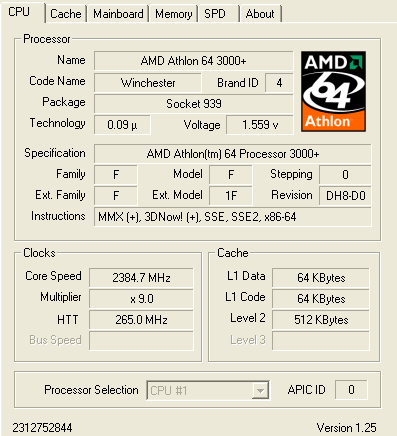How far will it go?
The Athlon 64 3000+'s 1.8GHz clock speed doesn't sound like a lot, does it?. Hell, AMD has surpassed that many moons ago with its S462 XP2500 CPU. Intel, on the other hand, has been firmly entrenched in the 3GHz+ category for well over a year. That's all true, but clock speed is only one determinant of overall processor performance. AMD has tried to educate the public to this fact, and even Intel is shying away from disclosing clock speeds on its very latest Pentium 4s.The secret to the Athlon 64's success lies in an excellent work-per-clock-cycle ratio. In other words, more is done with less MHz. That's been accomplished by using a low-latency, on-die memory controller, decent levels of L2 cache, and a significantly shorter integer pipeline than its immediate competition. Further performance gains have been engineered into these S939 wonders via the use of a wide 128-bit memory interface. Bags of bandwidth complementing sheer CPU grunt. The 64 nomenclature refers to the chips' ability to run 64-bit code. When optimised correctly and run on compatible software, 64-bit technology will add another performance dimension to CPUs that are rather quick at ripping through present 32-bit applications.
| CPU | Athlon 64 3000+ | Athlon 64 3200+ | Athlon 64 3500+ | Athlon 64 3800+ | Athlon 64 4000+ | Athlon 64 FX-55 |
| Clock speed | 1.8GHz | 2.0GHz | 2.2GHz | 2.4GHz | 2.4GHz | 2.6GHz |
| Multiplier | 9x | 10x | 11x | 12x | 12x | 13x |
| L2 cache | 512kb | 512kb | 512kb | 512kb | 1024kb | 1024kb |
| Manufacturing process | 90nm/130nm | 90nm/130nm | 90nm/130nm | 130nm | 130nm | 130nm |
| Operating voltage | 1.4/1.5v | 1.4/1.5v | 1.4/1.5v | 1.5v | 1.5v | 1.5v |
| Street price (25/11/04) | £110 | £145 | £190 | £420 | £500 | £575 |
The above table, in a nutshell, highlights the current Socket-939 line-up. The CPUs only differ by clock speed, cache levels, and operating voltage. Note the huge price jump from a 2.2GHz (3500+) model to a 3800+ 2.4GHz CPU. That 9% speed increase is accompanied by a 120% price hike. This pricing discrepancy indirectly highlights the difficulty AMD is having in releasing 2.4GHz+ S939 Athlon 64s. Also, Model 4000+ appears to be poor value. Another £75 buys you a 2600MHz multiplier-unlocked FX-55, Coming back to this review's objective, wouldn't it be fantastic if a £110 Winchester core-based Athlon 3000+ could hit the £420 Athlon 64 3800's basic speed?. That's the kind of impetus that drives enthusiasts.
As alluded to earlier, AMD also has a range of Athlon 64s in a Socket-754 form factor. These CPUs share all but one of S939's traits. The difference is an important one, as far as performance is concerned. S754 processors use single-channel memory (64-bit interface) as opposed to S939's dual-channel. On a clock-for-clock basis that amounts to a benchmark difference of up to 10%, so S754s tend to be around 10-15% cheaper.
The tools
All non-FX Athlon 64s are multiplier-locked above the default setting. It's done to stop unscrupulous system integrators running the Athlon 64 3000+ at, say, 2200MHz (11x200) and calling it an Athlon 3500+. FXs are the most expensive consumer-level AMD produces, so running totally unlocked isn't much of a problem. It also gives the rich enthusiast further options to play with. So, the only method of raising CPU MHz speed is to push up the driven clock until stability is compromised, either by CPU, motherboard or memory.
Such an approach requires a motherboard with explicitly locked AGP/PCI(e) buses, excellent voltage control, and, preferably, some high-speed memory that's capable of matching the elevated driven clock speed. There's little point in even considering overclocking if your motherboard's stability is compromised by out-of-spec bus rates. Coincidentally, we had an EPoX 9NDA3+ in for review that ran smoothly at 280MHz+. A 1GByte pack of Corsair's excellent TwinX XMS4400 memory (275MHz) allowed us to raise driven clock with synchronous memory support, too. HTT frequency was reduced to 4x, chipset voltage and DIMM voltages were raised to 1.7v and 2.8v, respectively. A reference AMD heatsink/fan was used as the only means of cooling, so it's a setup that many of you should be able to replicate without too much fuss.
Vcore was also raised to 1.55v and the driven clock raised in 10MHz increments until OS-loading failure. The purpose of this exercise was not to see a one-shot, unstable overclock. Rather, I wanted to examine overclocking with complete system stability in mind. Higher speeds aren't worth much if your PC's constantly rebooting and crashing.

A simple, effective, stable 30%+ overclock with a slight tinkering of voltages and frequencies. Adding CPU voltage didn't do much for stability beyond 2400MHz. The overclocked speed of 2.385GHz didn't cause a single issue when stressed over a 3-day period. I define a successful overclock as being one with default-level stability, and this certainly was that. Load CPU temperature at 1800MHz hovered around 42c. That rose to 51c with a ~30% hike on clock speed and 0.15v extra juice
Onwards, to see how it performed against some immediate competition.









